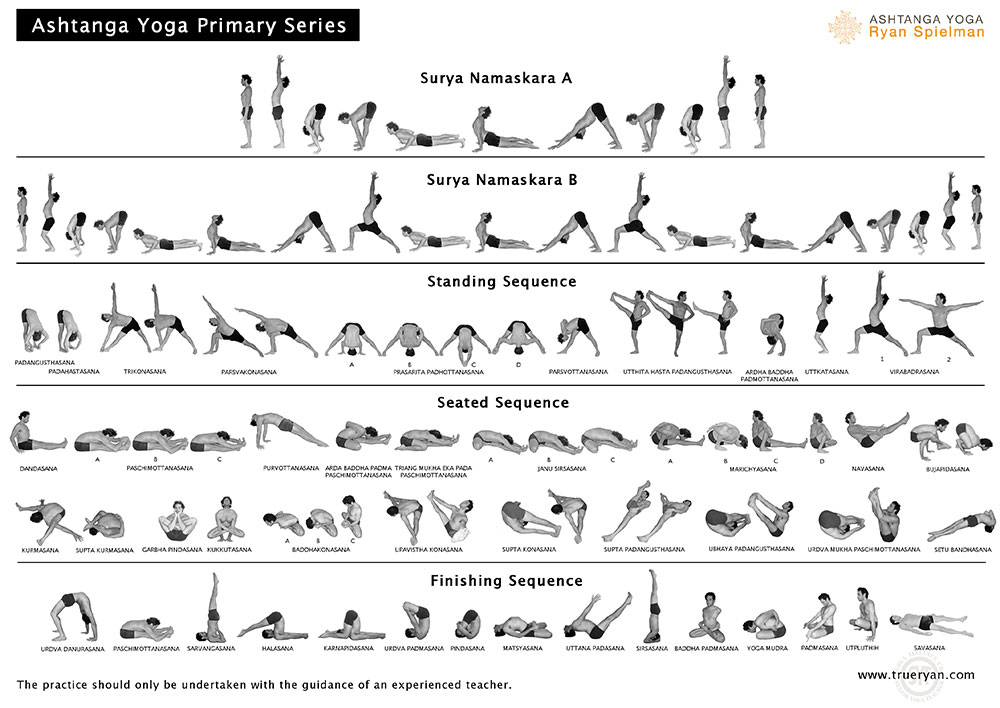A few months ago I decided to start doing Ashtanga yoga because I felt it was time to vary my yoga practice and challenge myself more. Over the last three years, apart from my home practice, most of the classes I’ve been going to have been Sivananda, which is quite a slow, restorative but intense practice. Prior to this, I did Iyengar yoga and other forms of Hatha yoga. Ashtanga as I’m sure you’re aware is more dynamic.
During my first class, I was in for a bit of a shock. My arms aren’t entirely lacking in muscle, but they certainly felt it during and after the class. The repetitive planks, upward facing dogs and arm balances were a real challenge. In the past I had always disliked postures which required a lot of arm strength. As the saying goes though — if you don’t like it, it probably means you need it — so I am now embracing greater strength and arm balances.
This post isn’t about my challenges with certain asanas or my history of practising yoga though, it’s about the Mysore style Ashtanga yoga class I went to at 6am this morning at Triyoga, Chelsea, taught by Ryan Spielman.
Giving Mysore style Ashtanga Yoga a go
I decided to go after one of the other Ashtanga teachers at Triyoga said we should all give the Mysore style of practising a go at some point and I’m glad I did. For those of you who don’t know, in Mysore style Ashtanga yoga, everyone works individually at their own pace whilst being assisted by a teacher. It’s quite a liberating way of doing yoga.
Depending on your level, you go through the Ashtanga sequence and then if there are any particular postures you’d like to focus on, you have the freedom to do so.
Although, I feel comfortable with most of the individual asanas in the primary series, I haven’t been to enough Ashtanga classes to know the order of the asanas off by heart. Knowing the sequence of course, is incredibly important and eventually, I want to be able to flow into each asana without thinking ‘errr what comes next?’ This is a practice all about the breath, grace and fluid movement — at least it feels like it to me. So far, my yoga practice has almost been about isolated asanas and spending sometimes up to five minutes in a posture.
It was helpful today to be taught pretty much 1-1 for the majority of the session, which is what happens when anyone new turns up to a Mysore style class. When you’re practising in large classes there’s not always the chance to make adjustments, so I now at least feel confident that I’m doing Surya Namaskar (Sun Salutation) A & B properly as well as some of the other asanas and also the breath count for each asana. Also, I now have something very specific to work on.
One of my worries eventhough I’ve been doing yoga since I was a teenager, is that I’ve actually been doing quite simple asanas wrong — seeing as the majority of my practice has been self taught. When you’re practising Mysore style, there’s no chance of this happening, so in many respects although it’s not a led class, the teaching felt a lot more thorough.
Today I basically worked very slowly through about two thirds of the Ashtanga primary series to get my head around the sequence of asanas. I just allowed myself to focus on my breath and do as much as I could in the moment, without desiring to do more. Ashtanga yoga is a pretty athletic and dynamic practice — at least compared to Sivananda or other slower forms of Hatha yoga. As a result, It’s a lot easier (if you’re not used to it!) to get tired more quickly and extremely sweaty, which means it’s more important than ever to work with the breath.
I also feel that it’s really healthy and perhaps for anyone who has been practising a certain style of yoga for a long time, to vary it. With Ashtanga yoga though, I feel there’s enough to keep you going for a lifetime! There’s no chance of saying ‘Right i’m done now — I can do it all.’
The other day I was reading an interview on Elephant Journal with Ashtanga teacher, Kino MacGregor, whose Youtube videos first got me into wanting to give Ashtanga yoga a go in the first place. In the interview she answers the question:
Is it difficult to stay grounded and humble without increasing the ego in the middle of a such big popular appeal? How do you balance these both sides of being a successful yoga teacher?
“The practice itself provides a solution for this because I am an eternal student facing the same struggles as every student on the path. There are constantly things that I cannot do like the Fourth Series postures I mentioned above. These keep me humble…” Read the rest of the interview with Kino MacGregor
So, will I be going back to a Mysore class?
Most definitely — although I’m away from London for the next week, so I will start again in a few weeks. I live a 25 minute cycle ride away from Triyoga, Chelsea, which is doable right? I’ve always wanted to start a regular morning practice, and I enjoyed today’s session so much and felt I learnt a lot, so perhaps it’s time to become more committed.
I’m currently training to be a yoga teacher with Yoga Professionals and YMCA Fit, and although it isn’t compulsory to try different styles of yoga, I feel it will help me once I start doing classes of my own.
Find out more about Mysore style Ashtanga classes in London and get free downloads of the Ashtanga primary series sequence here.
Image source: Trueryan.com

